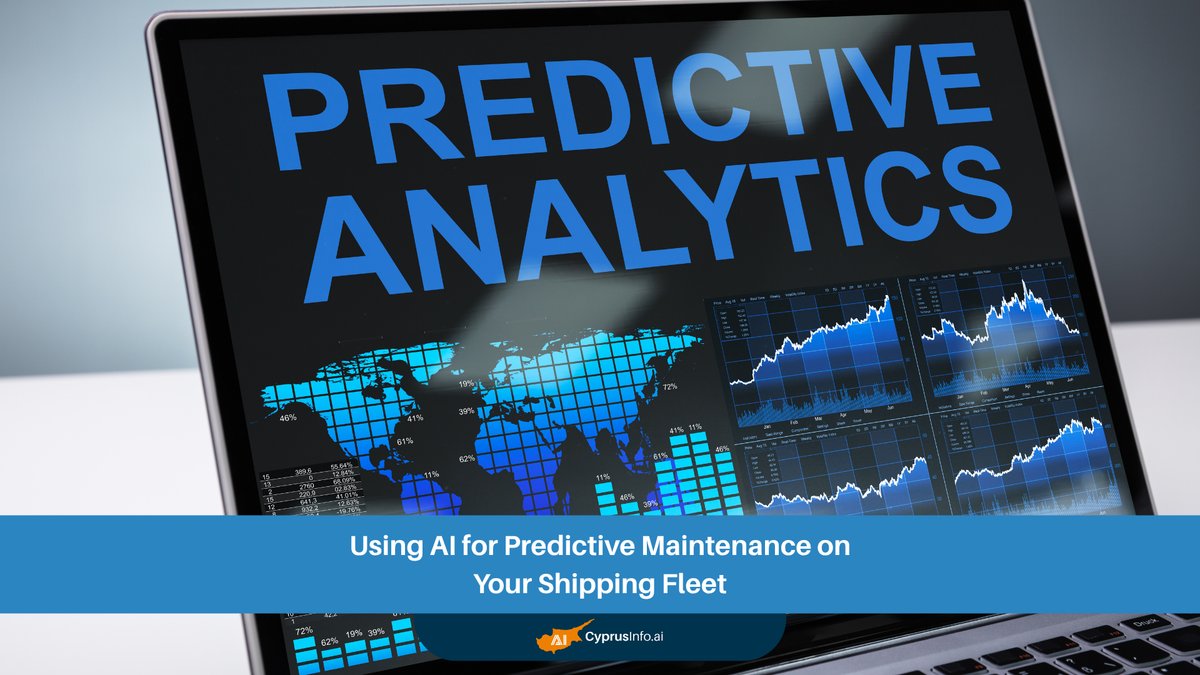The vast, intricate world of maritime logistics is undergoing a profound transformation. As global trade intensifies and the demand for efficient, reliable shipping grows, traditional maintenance paradigms are proving increasingly inadequate. Unscheduled breakdowns, costly repairs, and operational delays are no longer mere inconveniences; they represent significant financial drains and threaten supply chain integrity. This is where the innovative application of Artificial Intelligence (AI) for predictive maintenance in shipping emerges as a game-changer, promising to reshape how fleets operate and thrive in the 21st century. At its core, AI predictive maintenance shipping leverages advanced algorithms and real-time data to anticipate equipment failures before they occur. Instead of relying on fixed schedules or reacting to breakdowns, AI empowers shipping companies to transition to a proactive maintenance strategy, ensuring optimal performance, extended asset lifespan, and unparalleled operational continuity.
The Critical Need for Advanced Maintenance in Modern Shipping
Shipping fleets are complex ecosystems of highly engineered machinery, operating under some of the harshest conditions on Earth. Engines, propellers, generators, navigation systems – each component is vital. A single failure can cascade into significant problems:
Revenue Loss: Off-hire periods due to unexpected repairs.
Increased Costs: Emergency repairs, spare parts procurement in remote locations, and diverting vessels.
Safety Risks: Equipment malfunctions can endanger crew, cargo, and the marine environment.
Reputational Damage: Delays and incidents can harm a company's standing.
Regulatory Pressure: Growing scrutiny on environmental performance and operational safety.
Historically, maintenance has largely been either reactive (fixing things when they break) or time-based (scheduled inspections regardless of component health). While time-based maintenance offers some predictability, it often leads to unnecessary replacements or, conversely, misses impending failures, making it inefficient. The digital age, however, offers a smarter path: AI predictive maintenance shipping.
“The maritime industry, often seen as traditional, is now at the forefront of adopting advanced technologies like AI to enhance safety, efficiency, and sustainability. Predictive maintenance is not just an upgrade; it’s a necessity for competitive advantage.” – Industry Analyst
Understanding AI Predictive Maintenance Shipping: A Paradigm Shift
AI predictive maintenance shipping moves beyond traditional approaches by utilizing data science and machine learning to forecast the likelihood of equipment failure. It gathers data from a myriad of sources, including IoT sensors, historical maintenance logs, weather conditions, vessel performance metrics, and even cargo data. This vast dataset is then fed into sophisticated AI models that identify subtle patterns and anomalies indicative of future problems.
Key Points of AI Predictive Maintenance:
Data-Driven Insights: Moves from guesswork to informed decision-making.
Proactive Approach: Identifies potential failures before they manifest.
Optimized Resource Allocation: Ensures maintenance is performed only when truly needed.
Enhanced Safety: Reduces the risk of catastrophic failures at sea.
This paradigm shift is akin to a vessel gaining the ability to tell its crew, “My engine will likely need servicing in two weeks,” rather than simply stopping dead in the water. Such foresight allows for strategic planning, efficient resource allocation, and minimal disruption to operations.
How AI Powers Predictive Maintenance for Your Shipping Fleet
The implementation of AI predictive maintenance shipping involves several interconnected technological layers, all working in harmony to deliver actionable insights. From data collection to analysis and intervention, AI algorithms are at the heart of this transformative process.
1. Data Acquisition and IoT Integration for Vessel Health Monitoring Systems
The foundation of any effective predictive maintenance system is robust data. Modern shipping vessels are increasingly equipped with an array of IoT sensors that continuously monitor critical parameters: engine temperature, vibration levels, fuel consumption, lubricant quality, hull stress, pump pressure, and much more. These sensors generate massive volumes of real-time vessel data, which is then securely transmitted to a central processing unit, often via satellite communication.
Key Data Sources for AI Predictive Maintenance Shipping
Data Type | Examples | Purpose in AI PM |
|---|---|---|
Sensor Data | Engine RPM, temperature, pressure, vibration, fuel flow | Real-time operational health, anomaly detection |
Historical Maintenance | Repair logs, previous failure modes, service dates | Training AI models, understanding failure patterns |
Operational Data | Route taken, speed, cargo load, weather conditions | Contextualizing performance, environmental impact |
External Data | Market prices for spare parts, port congestion, weather forecasts | Optimizing logistics and planning |
2. Machine Learning and Advanced Analytics for Equipment Failure Prediction
Once collected, this continuous stream of real-time vessel data is fed into sophisticated machine learning models. These models are trained on historical data, learning the intricate relationships between various operational parameters and known equipment failure prediction in maritime scenarios. They can identify normal operating conditions and, more importantly, detect deviations that signify impending issues.
Algorithms commonly used include:
Regression Analysis: To predict continuous values like remaining useful life (RUL).
Classification Algorithms: To categorize anomalies and predict specific failure types.
Anomaly Detection: To flag unusual patterns that fall outside the norm.
Deep Learning: For complex data sets, especially from acoustic or vibration sensors.
These models continuously refine their understanding, improving their accuracy over time as they ingest more data, leading to increasingly precise equipment failure prediction.
3. Predictive Insights and Actionable Recommendations for Optimizing Maintenance Schedules Shipping
The output of the AI models isn't just raw data; it's translated into actionable insights. This includes alerts, diagnostic reports, and recommendations on optimizing maintenance schedules shipping. Maintenance crews and fleet managers receive timely notifications about specific components that require attention, along with an estimated timeframe before potential failure.
This allows for:
Scheduling maintenance during planned port calls or less critical operational periods.
Pre-ordering necessary spare parts, reducing lead times and costs.
Allocating skilled technicians more effectively.
This proactive approach significantly contributes to reducing unplanned downtime maritime operations often face.
Transformative Benefits of AI Predictive Maintenance Shipping
The advantages of adopting AI predictive maintenance shipping extend far beyond merely avoiding breakdowns. They impact every facet of maritime operations, from financial performance to environmental stewardship.
Significant Cost Reductions and Increased Fleet Operational Efficiency
By preventing unexpected failures, shipping companies can avoid the substantial costs associated with emergency repairs, diverted routes, and penalties for delayed deliveries. Maintenance activities can be consolidated and performed more efficiently during scheduled stops, drastically reducing labor and material expenses. This directly translates to improved fleet operational efficiency optimization.
Enhanced Safety and Regulatory Compliance
Reliable equipment is fundamental to maritime safety. AI predictive maintenance shipping systems proactively identify and flag components at risk, preventing situations that could endanger the crew, cargo, or vessel integrity. Furthermore, accurate maintenance records and improved operational reliability contribute to easier compliance with stringent international maritime regulations.
Extended Asset Lifespan and Sustainability
By maintaining equipment only when necessary, and precisely when it's most effective, wear and tear are minimized, extending the operational lifespan of expensive machinery. This reduction in premature replacements also supports sustainability goals by lowering waste and the environmental impact associated with manufacturing new parts.
“Sustainability in shipping isn't just about fuel efficiency; it's also about optimizing asset use and minimizing waste. AI predictive maintenance plays a crucial role in achieving these objectives.” – Maritime Sustainability Advocate
Optimized Maintenance Scheduling and Resource Management
Gone are the days of rigid, calendar-based maintenance that often leads to unnecessary work or missed critical issues. AI allows for dynamic, condition-based maintenance, ensuring resources (technicians, spare parts) are deployed exactly when and where they are most needed. This intelligent resource management enhances productivity across the entire fleet.
Competitive Advantage Through Maritime Digital Transformation
Early adopters of AI predictive maintenance shipping gain a significant competitive edge. Their fleets operate more reliably, with lower costs and higher uptime, enabling them to offer more consistent services and better pricing. Embracing maritime digital transformation strategies like this positions companies as industry leaders, attracting both clients and talent.
Implementing AI Predictive Maintenance Shipping: A Strategic Roadmap
Adopting AI predictive maintenance shipping is a strategic journey that requires careful planning and execution. It's not just a technological upgrade; it's an operational and cultural shift.
Phase 1: Assessment and Planning
Define Objectives: Clearly articulate what you aim to achieve (e.g., reduce downtime by X%, cut maintenance costs by Y%).
Pilot Project Selection: Identify a critical vessel or specific equipment for an initial pilot, ensuring manageable scope and high potential for impact.
Data Infrastructure Audit: Evaluate existing sensor capabilities, data collection, and storage systems. Identify gaps for IoT sensors for shipping fleets.
Stakeholder Alignment: Engage fleet managers, engineers, IT, and crew to ensure buy-in and address concerns.
Phase 2: Technology Integration and Data Collection
Sensor Deployment: Install necessary IoT sensors for shipping fleets on target equipment.
Data Platform Setup: Implement a scalable data platform capable of handling real-time vessel data analytics.
AI Model Training: Train machine learning applications in shipping using historical and newly collected data. This iterative process is crucial for accuracy.
System Integration: Connect the AI platform with existing Enterprise Resource Planning (ERP) and Computerized Maintenance Management Systems (CMMS).
Phase 3: Deployment, Monitoring, and Optimization
Rollout and User Training: Deploy the system across the pilot fleet and train crew and onshore teams.
Continuous Monitoring: Actively monitor performance, analyze alerts, and refine maintenance strategies.
Feedback Loop: Establish clear channels for feedback from technicians and operators to improve data-driven fleet management solutions.
Scalability: Plan for expanding the system across the entire fleet based on pilot success.
The Role of CyprusInfo.ai in Your Maritime Digital Transformation
Navigating the complexities of integrating cutting-edge AI solutions into your shipping operations can be challenging. This is where CyprusInfo.ai steps in as your strategic partner. We understand the unique demands of the maritime sector and offer tailored AI-powered solutions designed to enhance your fleet's efficiency and reliability. At CyprusInfo.ai, we provide comprehensive services to facilitate your journey into advanced AI predictive maintenance shipping:
AI Strategy & Consulting: Expert guidance on developing a bespoke AI roadmap for your fleet, identifying critical assets, and defining clear objectives for vessel health monitoring systems.
Data Infrastructure & IoT Integration: Assistance in setting up robust data collection frameworks, integrating IoT sensors for shipping fleets, and ensuring seamless real-time vessel data flow.
Custom AI Model Development: Building and deploying advanced machine learning applications in shipping specifically tailored to your vessel types and operational profiles for precise equipment failure prediction.
Implementation & Training: Hands-on support for integrating AI solutions with your existing systems and comprehensive training for your teams to ensure smooth adoption and maximum benefit.
Ongoing Optimization & Support: Continuous monitoring, refinement, and support for your AI predictive maintenance system, ensuring it evolves with your operational needs and industry advancements, leading to sustained reducing unplanned downtime maritime-wide.
Leveraging Local Expertise: For businesses operating within the region, our insights into the shipping industry in Cyprus and our understanding of AI maritime risk assessment provide an unparalleled advantage.
With CyprusInfo.ai, you gain a partner dedicated to driving your maritime digital transformation, empowering you to achieve significant cost savings, improve safety, and gain a decisive competitive edge in the global shipping market.
The Future of Shipping: Smart Fleets Driven by AI Predictive Maintenance
The maritime industry is on the cusp of a new era, defined by smart vessels and intelligent operations. AI predictive maintenance shipping is not just a trend; it's a foundational technology that will enable autonomous shipping, enhance environmental compliance, and redefine operational excellence. As AI models become even more sophisticated, integrating with digital twins and advanced simulation environments, the accuracy of equipment failure prediction will reach unprecedented levels. We can anticipate vessels that self-diagnose, self-optimize, and even self-heal in minor instances, further bolstering fleet operational efficiency.
“The smartest ship is one that knows itself. AI provides that self-awareness, allowing for truly proactive management of assets on the high seas.” – Maritime Technology Visionary
This future promises a more resilient, sustainable, and profitable shipping industry, where human ingenuity, augmented by AI, navigates the complexities of global trade with unparalleled precision.
For more insights into optimizing your operations, consider exploring how AI can transform broader aspects of your business, such as AI inventory management or even broader AI in supply chain management.
Frequently Asked Questions About AI Predictive Maintenance Shipping
What exactly is AI predictive maintenance in the context of shipping?
AI predictive maintenance shipping uses artificial intelligence and machine learning algorithms to analyze real-time and historical data from vessel equipment. Its goal is to predict potential failures before they occur, allowing for proactive maintenance scheduling and reducing unplanned downtime maritime operations. It moves beyond reactive or time-based maintenance.
What types of equipment can benefit from AI predictive maintenance on a shipping fleet?
Virtually all critical equipment on a shipping fleet can benefit. This includes main engines, auxiliary engines, generators, pumps, compressors, propulsion systems, navigation equipment, cargo handling gear, and even HVAC systems. Any component that generates sensor data or has historical maintenance records can be integrated into the vessel health monitoring systems.
How does AI collect data from vessels at sea?
Data is primarily collected through a network of IoT sensors for shipping fleets installed on various equipment. This real-time vessel data is then transmitted via satellite communication systems to an onshore data platform for analysis by AI models. Edge computing may also be used onboard for initial processing before transmission.
What is the typical ROI for implementing AI predictive maintenance shipping?
While ROI varies, companies typically see significant returns through reduced operational costs (emergency repairs, off-hire time), extended asset lifespan, lower spare parts inventory, and improved fuel efficiency due to optimized equipment performance. Some studies suggest a 10-40% reduction in maintenance costs and a substantial increase in fleet operational efficiency.
Are there cybersecurity concerns with AI predictive maintenance systems?
Yes, cybersecurity is a critical consideration. Secure data transmission, robust encryption, and protected cloud platforms are essential to prevent unauthorized access and data breaches. Implementing strong cybersecurity protocols is paramount for any maritime digital transformation strategy. You can find more information on data protection here.
How long does it take to implement AI predictive maintenance on a fleet?
Implementation time varies depending on fleet size, existing infrastructure, and the scope of the project. A pilot project on a single vessel or specific equipment might take a few months, while a full fleet-wide rollout could span 1-2 years, involving iterative phases of data collection, model training, and integration for optimizing maintenance schedules shipping.
What kind of expertise is needed to manage an AI predictive maintenance system?
Managing such a system typically requires a blend of expertise, including maritime engineers for operational context, data scientists for AI model interpretation and refinement, and IT professionals for infrastructure management. Training programs are often provided by solution providers to upskill existing staff in data-driven fleet management solutions.
Can AI predictive maintenance help with environmental compliance?
Absolutely. By ensuring equipment operates at peak efficiency, AI can help reduce fuel consumption and emissions. Predicting and preventing leaks or malfunctions of critical systems also reduces the risk of environmental incidents, supporting sustainability goals and regulatory adherence, including compliance with standards like those from the International Maritime Organization (IMO).
Is AI predictive maintenance suitable for older vessels or only new builds?
AI predictive maintenance can be adapted for both new builds and existing vessels. While new vessels often come with integrated sensor packages, older vessels can be retrofitted with IoT sensors for shipping fleets relatively easily. The key is the ability to collect reliable data for the AI models.
What are the main challenges in adopting AI predictive maintenance shipping?
Key challenges include initial investment costs, integrating new technology with legacy systems, ensuring data quality and availability, overcoming organizational resistance to change, and the need for specialized expertise. However, the long-term benefits of reducing unplanned downtime maritime operations often outweigh these initial hurdles.
Conclusion: Steering Towards a Smarter Maritime Future with AI Predictive Maintenance Shipping
The maritime industry is at a pivotal moment, with the opportunity to embrace advanced technologies that redefine efficiency, safety, and sustainability. AI predictive maintenance shipping stands out as a critical innovation, offering a clear pathway to smarter, more resilient fleet operations. By moving from reactive problem-solving to proactive anticipation, shipping companies can unlock immense value, from significant cost savings and enhanced safety to extended asset lifespans and a powerful competitive edge. Embracing AI for your predictive maintenance strategy is not merely an "upgrade"; it's a strategic imperative for navigating the complexities of modern global trade. It empowers data-driven fleet management, optimizes resource allocation, and ensures that your vessels remain at peak performance, ready to meet the demands of an ever-evolving world.



